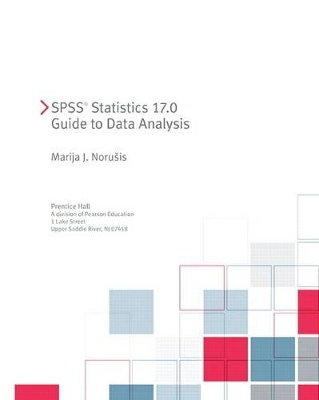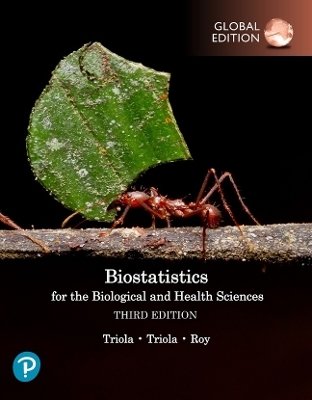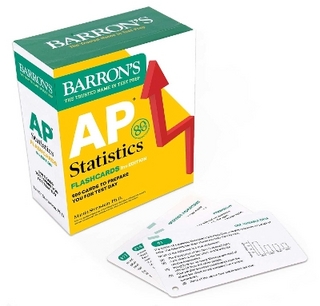
PASW Statistics 18 Guide to Data Analysis
Pearson
978-0-321-69058-6 (ISBN)
- Titel ist leider vergriffen;
keine Neuauflage - Artikel merken
Author Marija Norušis incorporates a wealth of real data, including the General Social Survey and studies of Internet usage, opinions of the criminal justice system, marathon running times, library patronage, and the importance of manners, throughout the examples and expanded chapter exercises. This unique combination of examples, exercises, and contemporary data gives you hands-on experience in analyzing data and makes learning about data analysis and statistical software relevant, unintimidating, and even fun!
A data CD-ROM is included with this book.
Marija Norušis earned a PhD in biostatistics from the University of Michigan. She was SPSS's first professional statistician. During this time, she wrote her first book, The SPSS Introductory Guide. Since then she has written numerous volumes of highly acclaimed SPSS documentation, and textbooks that demystify statistics and SPSS. Dr. Norušis has been on the faculties of the University of Chicago and Rush Medical College, teaching statistics to diverse audiences. When not working on SPSS guides, Marija analyzes real data as a statistical consultant. For more detailed information about Dr. Norušis and her SPSS guides, visit her website at www.norusis.com.
PART 1. GETTING STARTED WITH PASW STATISTICS
1. Introduction
About This Book
Getting Started with PASW Statistics
Describing Data
Testing Hypotheses
Examining Relationships
Lets Get Started
2. An Introductory Tour of PASW Statistics
Starting PASW Statistics
Help Is Always at Hand
Copying the Data Files
Opening a Data File
Statistical Procedures
The Viewer Window
Viewer Objects
The Data Editor Window
Entering Non-Numeric Data
Clearing the Data Editor without Saving Changes
The PASW Statistics Online Tutorial
The PASW Statistics Toolbar
The PASW Statistics Help System
Contextual Help
What’s Next?
3. Sources of Data
Know Your Data
Survey Data
Asking the Question
Measuring Time
Selecting Participants
Selecting a Sample
General Social Survey
Random-Digit Dialing
Internet Surveys
Designing Experiments
Random Assignment
Minimizing Bias
Summary
What’s Next?
Exercises
PART 2 DESCRIBING DATA
4. Counting Responses
Describing Variables
A Simple Frequency Table
Sorting Frequency Tables
Pie Charts
Bar Charts
Summarizing Internet Time
Histograms
Mode and Median
Percentiles
Summary
What’s Next?
How to Obtain a Frequency Table
Format: Appearance of the Frequency Table
Statistics: Univariate Statistics
Charts: Bar Charts, Pie Charts, and Histograms
Exercises
5. Computing Descriptive Statistics
Summarizing Data
Scales of Measurement
Mode, Median, and Arithmetic Average
Comparing Mean and Median
Summarizing Time Spent Online
Measures of Variability
Range
Variance and Standard Deviation
The Coefficient of Variation
Standard Scores
Summary
What’s Next?
How to Obtain Univariate Descriptive Statistics
Options: Choosing Statistics and Sorting Variables
Exercises
6. Comparing Groups
Age, Education, and Internet Use
Plotting Means
Layers: Defining Subgroups by More than One Variable
Summary
What’s Next?
How to Obtain Subgroup Means
Layers: Defining Subgroups by More than One Variable
Options: Additional Statistics and Display of Labels
Exercises
7. Looking at Distributions
Marathon Completion Times
Age and Gender
Marathon Times for Mature Runners
Summary
What’s Next?
How to Explore Distributions
Explore Statistics
Graphical Displays
Options
Exercises
8. Counting Responses for Combinations of Variables
Library Use and Education
Row and Column Percentages
Bar Charts
Adding Control Variables
Library Use and the Internet
Summary
What’s Next?
How to Obtain a Crosstabulation
Layers: Three or More Variables at Once
Cells: Percentages, Expected Counts, and Residuals
Bivariate Statistics
Format: Adjusting the Table Format
Exercises
9. Plotting Data
Examining Population Indicators
Simple Scatterplots
Scatterplot Matrices
Overlay Plots
Three-Dimensional Plots
Identifying Unusual Points
Rotating 3-D Scatterplots
Summary
What’s Next?
How to Obtain a Scatterplot
Obtaining a Simple Scatterplot
Obtaining an Overlay Scatterplot
Obtaining a Scatterplot Matrix
Obtaining a 3-D Scatterplot
Editing a Scatterplot
Exercises
PART 3. TESTING HYPOTHESES
10. Evaluating Results from Samples
From Sample to Population
A Computer Model
The Effect of Sample Size
The Binomial Test
Summary
What’s Next?
Exercises
11. The Normal Distribution
The Normal Distribution
Samples from a Normal Distribution
Means from a Normal Population
Are the Sample Results Unlikely?
Testing a Hypothesis
Means from Non-Normal Distributions
Means from a Uniform Distribution
Summary
What’s Next?
Exercises
12. Testing a Hypothesis about a Single Mean
Examining the Data
The T Distribution
Calculating the T Statistic
Confidence Intervals
Other Confidence Levels
Confidence Interval for a Difference
Confidence Intervals and Hypothesis Tests
Null Hypotheses and Alternative Hypotheses
Rejecting the Null Hypothesis
Summary
What’s Next?
How to Obtain a One-Sample T Test
Options: Confidence Level and Missing Data
Exercises
13. Testing a Hypothesis about Two Related Means
Marathon Runners in Paired Designs
Looking at Differences
Is the Mean Difference Zero?
Two Approaches
The Paired-Samples T Test
Are You Positive?
Some Possible Problems
Examining Normality
Summary
What’s Next?
How to Obtain a Paired-Samples T Test
Options: Confidence Level and Missing Data
Exercises
14. Testing a Hypothesis about Two Independent
Means
Examining Television Viewing
Distribution of Differences
Standard Error of the Mean Difference
Computing the T Statistic
Output from the Two-Independent-Samples T Test
Confidence Intervals for the Mean Difference
Testing the Equality of Variances
Effect of Outliers
Introducing Education
Can You Prove the Null Hypothesis?
Interpreting the Observed Significance Level
Power
Monitoring Death Rates
Does Significant Mean Important?
Summary
What’s Next?
How to Obtain an Independent-Samples T Test
Define Groups: Specifying the Subgroups
Options: Confidence Level and Missing Data
Exercises
15. One-Way Analysis of Variance
Hours in a Work Week
Describing the Data
Confidence Intervals for the Group Means
Testing the Null Hypothesis
Assumptions Needed for Analysis of Variance
Analyzing the Variability
Comparing the Two Estimates of Variability
The Analysis-of-Variance Table
Multiple Comparison Procedures
Television Viewing, Education, and Internet Use
Summary
What’s Next?
How to Obtain a One-Way Analysis of Variance
Post Hoc Multiple Comparisons: Finding the Difference
Options: Statistics and Missing Data
Exercises
16. Two-Way Analysis of Variance
The Design
Examining the Data
Testing Hypotheses
Degree and Gender Interaction
Necessary Assumptions
Analysis-of-Variance Table
Testing the Degree-by-Gender Interaction
Testing the Main Effects
Removing the Interaction Effect
Where Are the Differences?
Multiple Comparison Results
Checking Assumptions
A Look at Television
Extensions
Summary
What’s Next?
How to Obtain a GLM Univariate Analysis
GLM Univariate: Model
GLM Univariate: Plots
GLM Univariate: Post Hoc
GLM Univariate: Options
GLM Univariate: Save
Exercises
17. Comparing Observed and Expected Counts
Freedom or Manners?
Observed and Expected Counts
The Chi-Square Statistic
A Larger Table
Does College Open Doors?
A One-Sample Chi-Square Test
Power Concerns
Summary
What’s Next?
Exercises
18. Nonparametric Tests
Nonparametric Tests for Paired Data
Sign Test
Wilcoxon Test
Whos Sending E-mail?
Mann-Whitney Test
Kruskal-Wallis Test
Friedman Test
Summary
How to Obtain Nonparametric Tests
Chi-Square Test
Binomial Test
Two-Independent-Samples Tests
Several-Independent-Samples Tests
Two-Related-Samples Tests
Several-Related-Samples Tests
Options: Descriptive Statistics and Missing Values
Exercises
PART 4. EXAMINING RELATIONSHIPS
19. Measuring Association
Components of the Justice System
Proportional Reduction in Error
Measures of Association for Ordinal Variables
Concordant and Discordant Pairs
Measures Based on Concordant and Discordant Pairs
Evaluating the Components
Measuring Agreement
Correlation-Based Measures
Measures Based on the Chi-Square Statistic
Summary
What’s Next?
Exercises
20. Linear Regression and Correlation
Life Expectancy and Birthrate
Choosing the Best Line
Calculating the Least-Squares Line
Calculating Predicted Values and Residuals
Determining How Well the Line Fits
Explaining Variability
Some Warnings
Summary
What’s Next?
How to Obtain a Linear Regression
Statistics: Further Information on the Model
Residual Plots: Basic Residual Analysis
Linear Regression Save: Creating New Variables
Linear Regression Options
Exercises
21. Testing Regression Hypotheses
The Population Regression Line
Assumptions Needed for Testing Hypotheses
Testing Hypotheses
Testing that the Slope Is Zero
Confidence Intervals for the Slope and Intercept
Predicting Life Expectancy
Predicting Means and Individual Observations
Standard Error of the Predicted Mean
Confidence Intervals for the Predicted Means
Prediction Intervals for Individual Cases
Summary
What’s Next?
How to Obtain a Bivariate Correlation
Options: Additional Statistics and Missing Data
How to Obtain a Partial Correlation
Options: Additional Statistics and Missing Data
Exercises
22. Analyzing Residuals
Residuals
Standardized Residuals
Studentized Residuals
Checking for Normality
Checking for Constant Variance
Checking Linearity
Checking Independence
A Final Comment on Assumptions
Looking for Influential Points
Studentized Deleted Residuals
Summary
What’s Next?
Exercises
23. Building Multiple Regression Models
Predicting Life Expectancy
The Model
Assumptions for Multiple Regression
Examining the Variables
Looking at How Well the Model Fits
Examining the Coefficients
Interpreting the Partial Regression Coefficients
Changing the Model
Partial Correlation Coefficients
Tolerance and Multicollinearity
Beta Coefficients
Building a Regression Model
Methods for Selecting Variables
Summary
What’s Next?
How to Obtain a Multiple Linear Regression
Options: Variable Selection Criteria
Exercises
24. Multiple Regression Diagnostics
Examining Normality
Scatterplots of Residuals
Leverage
Changes in the Coefficients
Cook’s Distance
Plots against Independent Variables
Partial Regression Plot
Why Bother?
Summary
Exercises
Appendices
A. Obtaining Charts in PASW Statistics
Overview
Creating Bar Charts
Creating a Chart Comparing Groups of Cases
Data Summary Options
Creating a Chart Comparing Several Variables
Changing the Summary Statistic
Options in Creating Charts
Modifying Charts
Modifying Chart Options
Hints on Editing Charts
Saving Chart Files
Line and Area Charts
Pie Charts
Boxplots
Case Labels
Error Bar Charts
Histograms
Normal Probability Plots
B. Transforming and Selecting Data
Data Transformations
Transformations at a Glance
Saving Changes
Delaying Processing of Transformations
Recoding Values
Computing Variables
The Calculator Pad
Automatic Recoding
Conditional Transformations
Case Selection
Temporary or Permanent Selection
Other Selection Methods
C. The T Distribution
D. Areas under the Normal Curve
E. Descriptions of Data Files
F. Answers to Selected Exercises
Bibliography
Index
| Erscheint lt. Verlag | 6.5.2010 |
|---|---|
| Sprache | englisch |
| Maße | 230 x 187 mm |
| Gewicht | 998 g |
| Themenwelt | Mathematik / Informatik ► Mathematik ► Statistik |
| Technik | |
| ISBN-10 | 0-321-69058-3 / 0321690583 |
| ISBN-13 | 978-0-321-69058-6 / 9780321690586 |
| Zustand | Neuware |
| Informationen gemäß Produktsicherheitsverordnung (GPSR) | |
| Haben Sie eine Frage zum Produkt? |
aus dem Bereich

